
The composite image above – from John Ashley at Glacier National Park in Montana, in 2016 – perfectly captures the feeling of standing outside as dawn is approaching, after a peak night of Perseid meteor-watching. As viewed from anywhere in the Northern Hemisphere, the Perseids’ radiant point is highest at dawn, and so the meteors rain down from overhead. In 2020, the moon may somewhat intrude on this shower. View the full image here.
In 2020, the peak morning of the Perseid meteor shower is most likely August 12, under the light of a wide waning crescent moon. The mornings of August 11 and 13 are worth trying, too. The morning of August 13 will present a thinner and less bright moon than on the previous dates … and also more hours of dark sky for meteor watching. So moonrise is a key factor for watching 2020’s Perseid meteor shower. Visit the Sunrise Sunset Calendars to find out when the moon rises in your sky, remembering to check the moonrise and moonset box.
Also, keep in mind that the Perseids tend to be bright. So we expect a number of them to overcome the moonlit glare over the next several mornings. Will you see as many as 40 to 50 meteors per hour in the predawn hours? Maybe!
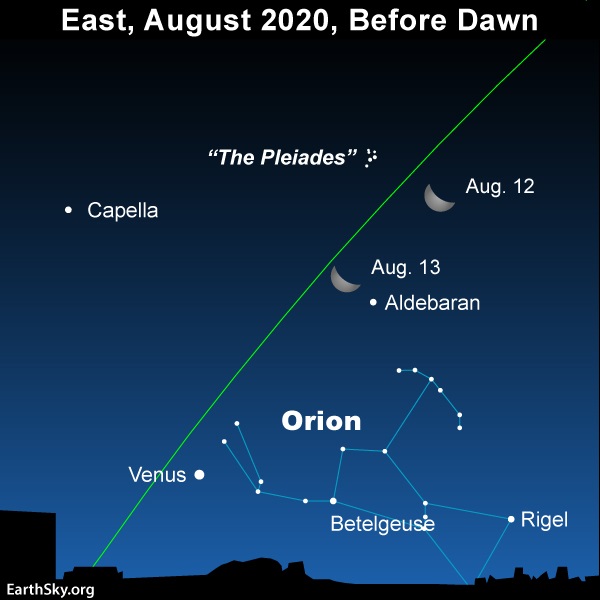
The thinner waning crescent moon on August 13 will be less obtrusive than the lunar crescent on August 12. The lit side of the waning moon points at the dazzling planet Venus, which beams near the club of Orion the Hunter.
Can you watch the shower in the evening hours before moonrise? Yes, in the Northern Hemisphere, you can, but the meteor numbers are rather modest in the evening hours. However, evening is the best time of night to try to catch an earthgrazer, which is an elongated, long-lasting meteor that travels horizontally across the sky. Earthgrazers are rare but most memorable if you’re lucky enough to spot one.
What if you’re in the Southern Hemisphere? From the Southern Hemisphere, the first meteors – and possible earthgrazers – won’t be flying until after midnight or the wee hours of the morning. In either the Northern or the Southern Hemisphere, the greatest number of meteors streak the sky in the few hours before dawn.

View larger. Annie Lewis told us, “Finally the clouds cleared. Perseid meteor just before dawn (August 13, 2019) in Madrid, Spain.” Thank you Annie!
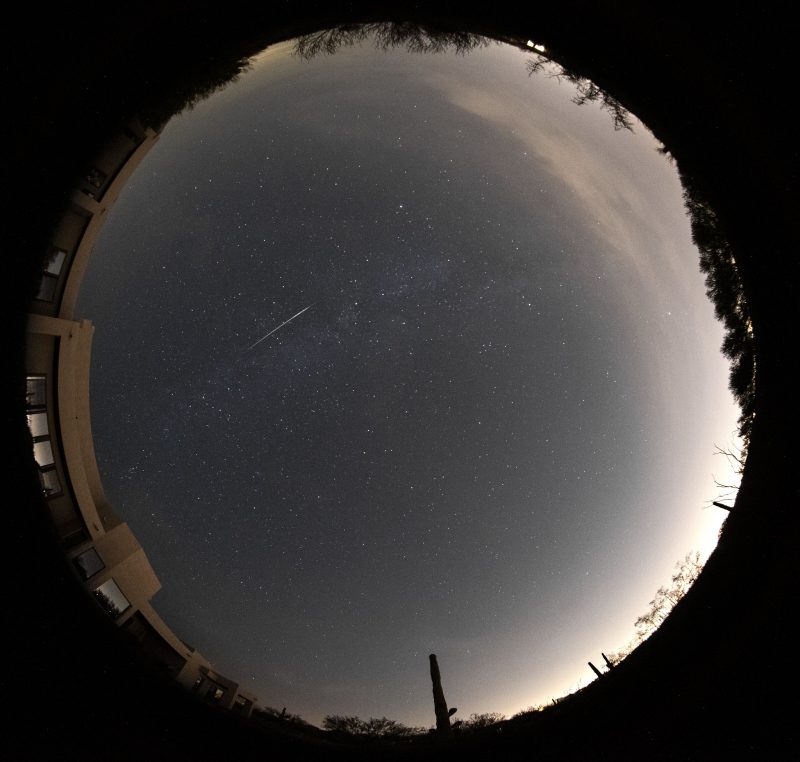
The Perseids begin in July every year and rise slowly to their August peak. Eliot Herman in Tucson, Arizona, captured this bright Perseid meteor on the morning of August 8, 2019. Thank you, Eliot!
Enjoying EarthSky so far? Sign up for our free daily newsletter today!
The earliest historical account of Perseid activity comes from a Chinese record in 36 A.D., where it was said that:
… more than 100 meteors flew in the morning.
Numerous references to the August Perseids appear in Chinese, Japanese and Korean records throughout the 8th, 9th, 10th and 11th centuries. Meanwhile, according to ancient western skylore, the Perseid shower commemorates the time when the god Zeus visited the mortal maiden Danaë in the form of a shower of gold. Zeus and Danaë became the parents of Perseus the Hero, from whose constellation the Perseid meteors radiate. More about the Perseid’s radiant point below.
The Perseid meteors happen around this time every year, as Earth in its orbit crosses the orbital path of Comet Swift-Tuttle. Dusty debris left behind by this comet smashes into Earth’s upper atmosphere, lighting up the nighttime as fiery Perseid meteors. The meteors start out slowly in the evening hours, begin to pick up steam after midnight and put out the greatest numbers in the dark hours before dawn.
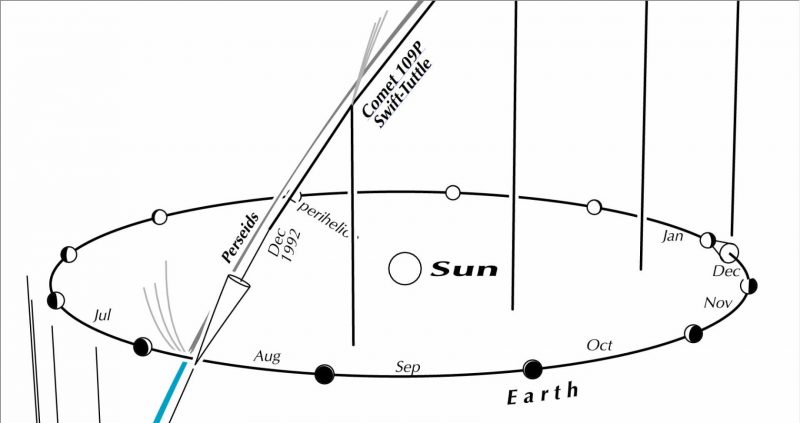
You might catch a meteor in moonlight tonight, or the shower might be a bust for you in 2020. Never fear. The Perseids will come again next year. Their parent comet – Swift-Tuttle – takes about 130 years to orbit the sun once. It last rounded the sun in the early 1990s and is now far away. But we see the Perseids each year, when Earth intersects the comet’s orbit, and debris left behind by Swift-Tuttle enters our atmosphere. Chart via Guy Ottewell.
The paths of the Perseid meteors, when traced backward, appear to originate in the constellation Perseus. Hence, this meteor shower’s name. While out there peering into dark skies, try looking for the Perseid’s radiant point. You don’t need to find it to enjoy the meteors, but it’s fun to find.
Perseus itself isn’t all that easy to find, but a nearby constellation – Cassiopeia the Queen – is. Look northward for Cassiopeia. It has a very distinctive shape of the letter W or the number 3. See it? Good.
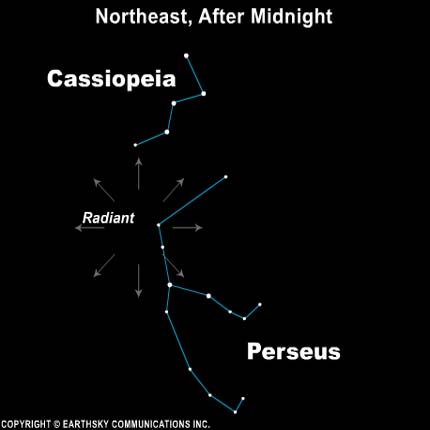
The constellation Perseus, radiant for the annual Perseid meteor shower. The easy-to-spot constellation Cassiopeia is nearby.
Want to go deeper? Then look for the Double Cluster in Perseus. This dual cluster of stars almost exactly marks the radiant point of the Perseid meteor shower. You can find it by scanning with your binoculars between Perseus and Cassiopeia.
Although the Double Cluster can be seen with the unaided eye in a dark country sky, the Double Clusters’ stars burst into view through binoculars. The clusters are more formally known as NGC 884 (Chi Persei) and NGC 869 (h Persei). The Double Cluster is thought to be over 7,000 light-years away from us, in the Perseus arm of the Milky Way galaxy.
Now here’s the good news. You don’t need to know the constellation Perseus to watch the Perseid meteor shower. You don’t need to find the radiant point. The Perseids do radiate from there, but they will appear in all parts of a dark night sky.
Here’s all you do need to know about the radiant point. As viewed from the Northern Hemisphere, the radiant sits low in the northeast sky at evening and climbs upward throughout the night. The higher that the radiant is in your sky, the more Perseid meteors you’re likely to see. For the Perseids, the radiant is highest before dawn.
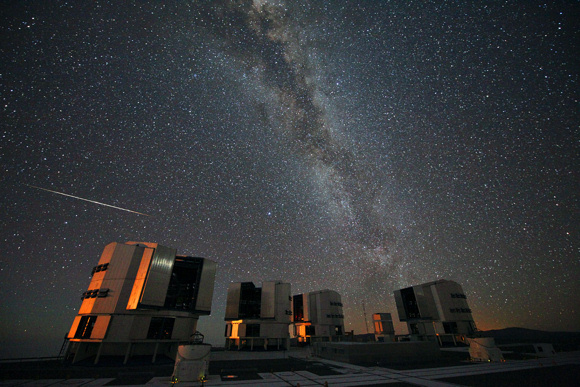
Some Perseid meteors will be visible in the Southern Hemisphere, although the numbers will not be as high. Photo from northern Chile, via the European Southern Observatory/ S. Guisard.
Looking for a dark area to observe from? Check out EarthSky’s interactive, worldwide Best Places to Stargaze map.
Bottom line: The greatest number of Perseid meteors is most likely to fall during the predawn hours on August 12, yet under the light of a wide waning crescent moon. The mornings of August 11 and 13 are surely worth trying, too. Will you see as many as 40 to 50 meteors per hour at the shower’s peak, in the moonlight? Maybe!
EarthSky’s meteor shower guide for 2020
Top 10 tips for meteor watchers
from EarthSky https://ift.tt/33mnViZ

The composite image above – from John Ashley at Glacier National Park in Montana, in 2016 – perfectly captures the feeling of standing outside as dawn is approaching, after a peak night of Perseid meteor-watching. As viewed from anywhere in the Northern Hemisphere, the Perseids’ radiant point is highest at dawn, and so the meteors rain down from overhead. In 2020, the moon may somewhat intrude on this shower. View the full image here.
In 2020, the peak morning of the Perseid meteor shower is most likely August 12, under the light of a wide waning crescent moon. The mornings of August 11 and 13 are worth trying, too. The morning of August 13 will present a thinner and less bright moon than on the previous dates … and also more hours of dark sky for meteor watching. So moonrise is a key factor for watching 2020’s Perseid meteor shower. Visit the Sunrise Sunset Calendars to find out when the moon rises in your sky, remembering to check the moonrise and moonset box.
Also, keep in mind that the Perseids tend to be bright. So we expect a number of them to overcome the moonlit glare over the next several mornings. Will you see as many as 40 to 50 meteors per hour in the predawn hours? Maybe!

The thinner waning crescent moon on August 13 will be less obtrusive than the lunar crescent on August 12. The lit side of the waning moon points at the dazzling planet Venus, which beams near the club of Orion the Hunter.
Can you watch the shower in the evening hours before moonrise? Yes, in the Northern Hemisphere, you can, but the meteor numbers are rather modest in the evening hours. However, evening is the best time of night to try to catch an earthgrazer, which is an elongated, long-lasting meteor that travels horizontally across the sky. Earthgrazers are rare but most memorable if you’re lucky enough to spot one.
What if you’re in the Southern Hemisphere? From the Southern Hemisphere, the first meteors – and possible earthgrazers – won’t be flying until after midnight or the wee hours of the morning. In either the Northern or the Southern Hemisphere, the greatest number of meteors streak the sky in the few hours before dawn.

View larger. Annie Lewis told us, “Finally the clouds cleared. Perseid meteor just before dawn (August 13, 2019) in Madrid, Spain.” Thank you Annie!

The Perseids begin in July every year and rise slowly to their August peak. Eliot Herman in Tucson, Arizona, captured this bright Perseid meteor on the morning of August 8, 2019. Thank you, Eliot!
Enjoying EarthSky so far? Sign up for our free daily newsletter today!
The earliest historical account of Perseid activity comes from a Chinese record in 36 A.D., where it was said that:
… more than 100 meteors flew in the morning.
Numerous references to the August Perseids appear in Chinese, Japanese and Korean records throughout the 8th, 9th, 10th and 11th centuries. Meanwhile, according to ancient western skylore, the Perseid shower commemorates the time when the god Zeus visited the mortal maiden Danaë in the form of a shower of gold. Zeus and Danaë became the parents of Perseus the Hero, from whose constellation the Perseid meteors radiate. More about the Perseid’s radiant point below.
The Perseid meteors happen around this time every year, as Earth in its orbit crosses the orbital path of Comet Swift-Tuttle. Dusty debris left behind by this comet smashes into Earth’s upper atmosphere, lighting up the nighttime as fiery Perseid meteors. The meteors start out slowly in the evening hours, begin to pick up steam after midnight and put out the greatest numbers in the dark hours before dawn.

You might catch a meteor in moonlight tonight, or the shower might be a bust for you in 2020. Never fear. The Perseids will come again next year. Their parent comet – Swift-Tuttle – takes about 130 years to orbit the sun once. It last rounded the sun in the early 1990s and is now far away. But we see the Perseids each year, when Earth intersects the comet’s orbit, and debris left behind by Swift-Tuttle enters our atmosphere. Chart via Guy Ottewell.
The paths of the Perseid meteors, when traced backward, appear to originate in the constellation Perseus. Hence, this meteor shower’s name. While out there peering into dark skies, try looking for the Perseid’s radiant point. You don’t need to find it to enjoy the meteors, but it’s fun to find.
Perseus itself isn’t all that easy to find, but a nearby constellation – Cassiopeia the Queen – is. Look northward for Cassiopeia. It has a very distinctive shape of the letter W or the number 3. See it? Good.

The constellation Perseus, radiant for the annual Perseid meteor shower. The easy-to-spot constellation Cassiopeia is nearby.
Want to go deeper? Then look for the Double Cluster in Perseus. This dual cluster of stars almost exactly marks the radiant point of the Perseid meteor shower. You can find it by scanning with your binoculars between Perseus and Cassiopeia.
Although the Double Cluster can be seen with the unaided eye in a dark country sky, the Double Clusters’ stars burst into view through binoculars. The clusters are more formally known as NGC 884 (Chi Persei) and NGC 869 (h Persei). The Double Cluster is thought to be over 7,000 light-years away from us, in the Perseus arm of the Milky Way galaxy.
Now here’s the good news. You don’t need to know the constellation Perseus to watch the Perseid meteor shower. You don’t need to find the radiant point. The Perseids do radiate from there, but they will appear in all parts of a dark night sky.
Here’s all you do need to know about the radiant point. As viewed from the Northern Hemisphere, the radiant sits low in the northeast sky at evening and climbs upward throughout the night. The higher that the radiant is in your sky, the more Perseid meteors you’re likely to see. For the Perseids, the radiant is highest before dawn.

Some Perseid meteors will be visible in the Southern Hemisphere, although the numbers will not be as high. Photo from northern Chile, via the European Southern Observatory/ S. Guisard.
Looking for a dark area to observe from? Check out EarthSky’s interactive, worldwide Best Places to Stargaze map.
Bottom line: The greatest number of Perseid meteors is most likely to fall during the predawn hours on August 12, yet under the light of a wide waning crescent moon. The mornings of August 11 and 13 are surely worth trying, too. Will you see as many as 40 to 50 meteors per hour at the shower’s peak, in the moonlight? Maybe!
EarthSky’s meteor shower guide for 2020
Top 10 tips for meteor watchers
from EarthSky https://ift.tt/33mnViZ

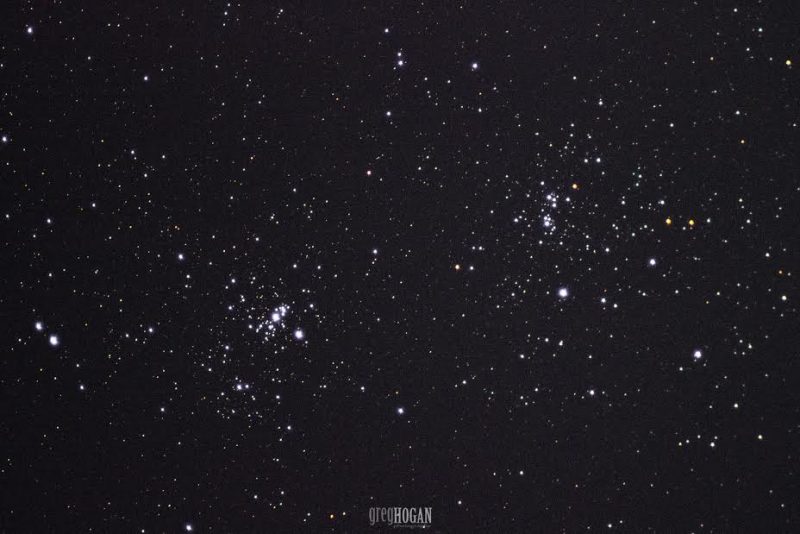
Aucun commentaire:
Enregistrer un commentaire